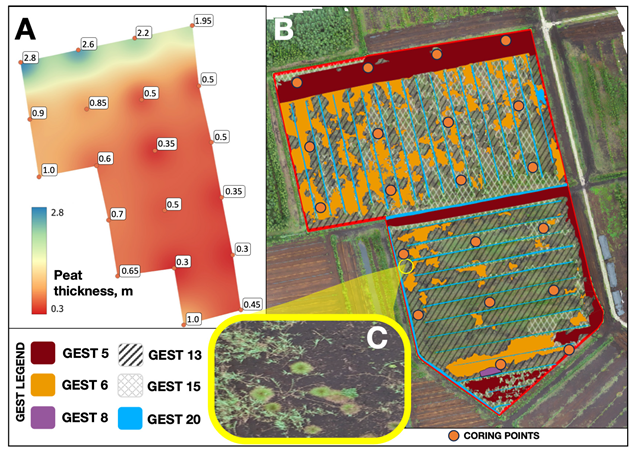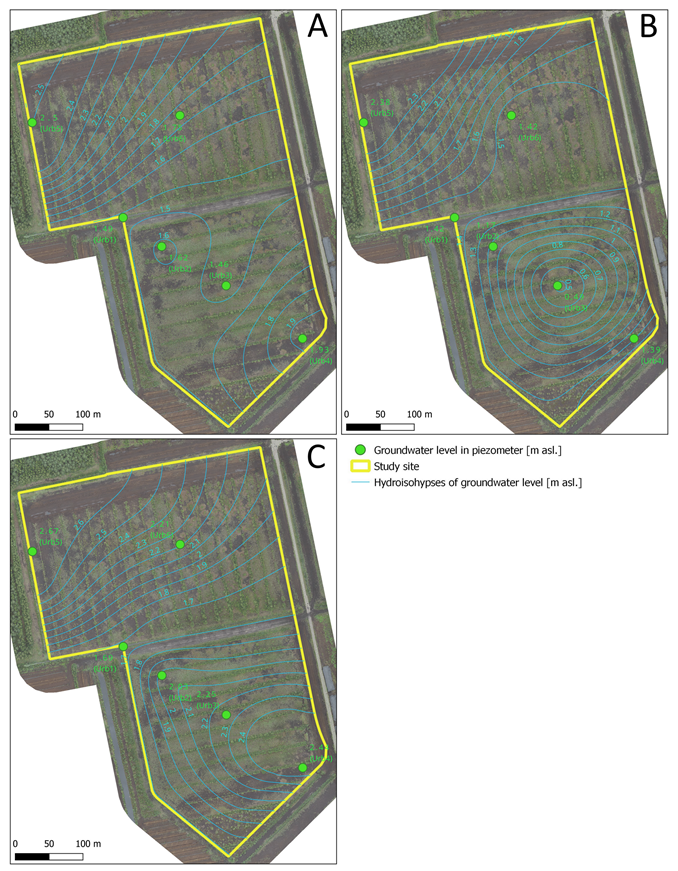Hands-On Approach to Foster Paludiculture Implementation and Carbon Certification on Extracted Peatland in Latvia
Abstract
1. Introduction
2. Materials and Methods
- (1)
- Explore peat thickness (geological coring within 100 × 100 m frame and following interpolation in QGIS) and its characteristics (botanical type, pH and decomposition rate [20], relative composition (loss-on-ignition [21]), and carbon stock [22] analyses with a summary statistics (PAST software v. 4.14 [23]) for nine samples and upscale estimates for the whole area);
- (2)
- Run water monitoring (six groundwater monitoring wells equipped with TD-Diver (vanEssen Instruments, Delft, The Netherlands) groundwater level loggers);
- (3)
- Sample groundwater and surface water for chemical (Ca2+, Mg2+, Na+, K+, HCO3−, SO42−, Cl−, Ntotal, NH4+, N-NH4+, N-NO2−, N-NO3−, Ptotal, PO43−) analyses in the accredited laboratory and onsite properties using express tests (pH, electric conductivity, alkalinity, iron concentration; Dist3 and pHep+, HI775, HI96721 Hanna Instruments, Avizieniai, Lithuania);
- (4)
- (5)
- Apply photogrammetry (with DJI Phantom RTK drone, 8.8 mm FC6310R camera 5472 × 3648, resolution for pixel 2.41 × 2.41 µm; five ground control points tied with GPS Emlid RS2+ RTK GNSS) to obtain high-resolution landcover and digital elevation model maps (using Agisoft Metashape Professional software (v. 2.0.1.) and QGIS) for landcover zonation;
- (6)
- Estimate GHG based on GEST [25];
- (7)
- Make 2D groundwater flow models (QGIS, thinPlateSpline interpolation method on observed water levels + boundary conditions using Lidar data) to understand water dynamics;
- (8)
- Propose further steps according to the results.
3. Results
4. Discussion
5. Conclusions
Author Contributions
Funding
Data Availability Statement
Acknowledgments
Conflicts of Interest
References
- Swindles, G.T.; Morris, P.J.; Mullan, D.J.; Payne, R.J.; Roland, T.P.; Amesbury, M.J.; Lamentowicz, M.; Turner, T.E.; Gallego-Sala, A.; Sim, T.; et al. Widespread drying of European peatlands in recent centuries. Nat. Geosci. 2019, 12, 922–928. [Google Scholar] [CrossRef]
- IPCC. Climate Change 2022: Impacts, Adaptation and Vulnerability. Contribution of Working Group II to the Sixt Assessment Report of the Intergovernmental Panel on Climate Change; Portner, H.-O., Roberts, D.C., Tignor, M., Poloczanska, E.S., Mintenbeck, K., Alegria, A., Craig, M., Langsdorf, S., Loschke, S., Moller, V., et al., Eds.; Cambridge University Press: Cambridge, UK; New York, NY, USA, 2022; 3056p. [Google Scholar] [CrossRef]
- UNFCCC (United Nations Framework Convention on Climate Change). The Paris Agreement; Phoenix Design Aid: Randers, Denmark, 2016; 60p. [Google Scholar]
- EU. Legislative Proposal on a Union Certification Framework for Carbon Removals. In “A European Green Deal”. 2022. Available online: https://www.europarl.europa.eu/legislative-train/theme-a-european-green-deal/file-carbon-removal-certification (accessed on 12 May 2023).
- Aitova, E.; Morley, T.; Wilson, D.; Renou-Wilson, F. A review of greenhouse gas emissions and removals from Irish peatlands. Mires Peat 2023, 29, 17. [Google Scholar] [CrossRef]
- Tiemeyer, B.; Freibauer, A.; Borraz, E.A.; Augustin, J.; Bechtold, M.; Beetz, S.; Beyer, C.; Ebli, M.; Eickenscheidt, T.; Fiedler, S.; et al. A new methodology for organic soils in national greenhouse gas inventories: Data synthesis, derivation and application. Ecol. Indic. 2020, 109, 105838. [Google Scholar] [CrossRef]
- Villa, J.A.; Bernal, B. Carbon sequestration in wetlands, from science to practice: An overview of the biogeochemical process, measurement methods, and policy framework. Ecol. Eng. 2018, 114, 115–128. [Google Scholar] [CrossRef]
- Schenuit, F.; Gidden, M.J.; Boettcher, M.; Brutschin, E.; Fyson, C.; Gasser, T.; Geden, O.; Lamb, W.F.; Mace, M.J.; Minx, J.; et al. Secure robust carbon dioxide removal policy through credible certification. Commun. Earth Environ. 2023, 4, 349. [Google Scholar] [CrossRef]
- Latvia’s National Climate and Energy Plan 2021–2030. Available online: https://energy.ec.europa.eu/system/files/2020-04/lv_final_necp_main_en_0.pdf (accessed on 22 November 2023).
- Peters, J.; von Unger, M. Peatlands in the EU Regulatory Environment. Survey with Case Studies on Poland and Estonia; BfN Federa Agency for Nature Conservation: Bonn, Germany, 2017; 103p, Available online: https://d-nb.info/1130157946/04 (accessed on 20 June 2023).
- Abel, S.; Kallweit, T. Potential Paludiculture Plants of the Holarctic; Greifswald mire centre: Greifswald, Germany, 2022; 440p, Available online: https://www.greifswaldmoor.de/files/dokumente/GMC%20Schriften/2022_Abel%20&%20Kallweit_2022_DPPP_Holarctis.pdf (accessed on 5 February 2023).
- Sechi, V.; van Belle, J.; Fritz, C.F.; Tilak, A.; Geurts, J.; Roehrig, N.; Nailon, P.; Cartmell-Done, K.; Liu, W.; Smits, T.; et al. Towards a Carbon Credit & Blue Credit Scheme for Peatlands. White Paper. Interreg NEW Carbon CONNECTS & Care-Peat Project Partnership, 2021. 2023. Available online: https://vb.nweurope.eu/media/19605/carbon-blue-credit-white-paper-january-2023.pdf (accessed on 13 November 2023).
- Wichtmann, W.; Schroder, C.; Joosten, H. Paludiculture–Productive Use of Wet Peatlands. Climate Protection–Biodiversity–Regional Economic Benefits; Schwizerbart Sience Publishers: Stuttgart, Germany, 2016; p. 272. ISBN 978-3-510-65283-9. [Google Scholar]
- Joosten, H.; Sirin, A.; Couwenberg, J.; Laine, J.; Smith, P. The role of peatlands in climate regulation. In Peatland Restoration and Ecosystem Services: Science, Policy and Practice; Bonn, A., Allott, T., Evans, M., Joosten, H., Stoneman, R., Eds.; Cambridge University Press: Cambridge, UK, 2016. [Google Scholar] [CrossRef]
- Emmer, I.; Couwenber, J. VM0036. Methodology for Rewetting Drained Temperate Peatlands. Version 1.0. Silvestrum Climate Associates, University of Greifswald. 2017. Available online: https://verra.org/wp-content/uploads/2018/03/VM0036-Rewetting-Drained-Temperate-Peatlands-v1.0.pdf (accessed on 10 January 2023).
- VERRA. Verified Carbon Standard. 2023. Available online: https://verra.org/methodologies/vm0036-methodology-for-rewetting-drained-temperate-peatlands-v1-0/ (accessed on 26 November 2023).
- MoorFutures. Der MoorFutures-Standard. 2023. Available online: https://www.moorfutures.de/konzept/moorfutures-standard/ (accessed on 26 November 2023).
- Paoli, R.; Feofilovs, M.; Kamenders, A.; Romagnoli, F. Peat production for horticultural use in the Latvian context: Sustainability assessment through LCA modeling. J. Clean. Prod. 2022, 378, 134559. [Google Scholar] [CrossRef]
- Ozola, I.; Dauskane, I.; Aunina, I.; Stivrins, N. Paludiculture in Latvia–existing knowledge and challenges. Land 2023, 12, 2039. [Google Scholar] [CrossRef]
- Chambers, F.M.; Beilman, D.W.; Yu, Z. Methods for determining peat humification and for quantifying peat bulk density, organic matter and carbon content for palaeostudies of climate and peatland carbon dynamics. Mires Peat 2010, 7, 1–10. Available online: http://pixelrauschen.de/wbmp/media/map07/map_07_07.pdf (accessed on 22 August 2022).
- Heiri, O.; Lotter, A.F.; Lemcke, G. Loss on ignition as a method for estimating organic and carbonate content in sediments: Reproductibility and comparability of results. J. Paleolimnol. 2001, 25, 101–110. [Google Scholar] [CrossRef]
- Loisel, J.; Yu, Z. Recent acceleration of carbon accumulation in boreal peatlands, south central Alaska. J. Geophys. Res. Biogeosciences 2013, 118, 41–53. [Google Scholar] [CrossRef]
- Hammer, Ø.; Harper, D.A.T.; Ryan, P.D. PAST: Paleontological statistics software package for education and data analysis. Palaeontol. Electron. 2001, 4, 9. Available online: https://palaeo-electronica.org/2001_1/past/past.pdf (accessed on 15 September 2023).
- Couwenberg, J.; Thiele, A.; Tanneberger, F.; Augustin, J.; Barisch, S.; Dubovik, D.; Liashchynskaya, N.; Michaelis, D.; Minke, M.; Skuratovich, A.; et al. Assessing greenhouse gas emissions from peatlands using vegetation as a proxy. Hydrobiologia 2011, 674, 67–89. [Google Scholar] [CrossRef]
- Jarašius, L.; Etzold, J.; Truus, L.; Purre, A.-H.; Sendžikaitė, J.; Strazdiņa, L.; Zableckis, N.; Pakalne, M.; Bociąg, K.; Ilomets, M.; et al. Handbook for Assessment of Greenhouse Gas Emissions from Peatlands. Applications of Direct and Indirect Methods by LIFE Peat Restore; Lithuanian Fund for Nature: Vilnius, Lithuania, 2022; p. 201. [Google Scholar]
- Temmink, R.J.M.; Fritz, C.; van Dijk, G.; Hensgens, G.; Lamers, L.P.M.; Krebs, M.; Gaudig, G.; Joosten, H. Sphagnum farming in a eutrophic world: The importance of optimal nutrient stoichiometry. Ecol. Eng. 2017, 98, 196–205. [Google Scholar] [CrossRef]
- Jassey, V.E.J.; Reczuga, M.K.; Zielińska, M.; Słowińska, S.; Robroek, B.J.M.; Mariotte, P.; Seppey, C.V.W.; Lara, E.; Barabach, J.; Słowiński, M.; et al. Tipping point in plant-fungal interactions under severe drought causes abrupt rise in peatland ecosystem respiration. Glob. Chang. Biol. 2018, 24, 972–986. [Google Scholar] [CrossRef] [PubMed]
- Wilson, D.; Blain, D.; Couwenberg, J.; Evans, C.D.; Muriyarso, D.; Page, S.E.; Renou-Wilson, F.; Rieley, J.O.; Sirin, A.; Strack, M.; et al. Greenhouse gas emission factors associated with rewetting of organic soils. Mires Peat 2016, 17, 1–28. Available online: http://mires-and-peat.net/media/map17/map_17_04.pdf (accessed on 4 July 2023).
- Dinsmore, K.J.; Skiba, U.M.; Billett, M.F.; Rees, R.M. Effect of water table on greenhouse gas emissions from peatland mesocosms. Plant Soil 2008, 318, 229–242. [Google Scholar] [CrossRef]
- Tanneberger, F.; Birr, F.; Couwenberg, J.; Kaiser, M.; Luthardt, V.; Nerger, M.; Pfister, S.; Oppermann, R.; Zeitz, J.; Beyer, C.; et al. Saving soil carbon, greenhouse gas emissions, biodiversity and the economy: Paludiculture as sustainable land use option in german fen peatlands. Reg. Environ. Chang. 2022, 22, 69. [Google Scholar] [CrossRef]
- Günther, A.; Barthelmes, A.; Huth, V.; Joosten, H.; Jurasinski, G.; Koebsch, F.; Couwenberg, J. Prompt rewetting of drained peatlands reduces climate warming despite methane emissions. Nat. Commun. 2020, 11, 1644. [Google Scholar] [CrossRef] [PubMed]
- Kreyling, J.; Tanneberger, F.; Jansen, F.; van der Linden, S.; Aggenbach, C.; Blüml, V.; Couwenberg, J.; Emsens, W.-J.; Joosten, H.; Klimkowska, A.; et al. Rewetting does not return drained fen peatlands to their old selves. Nat. Commun. 2021, 12, 5693. [Google Scholar] [CrossRef] [PubMed]
- Mander, Ü.; Järveoja, J.; Maddison, M.; Sooaar, K.; Aavola, R.; Ostonen, I.; Salm, J.-O. Reed canary grass cultivation mitigates greenhouse gas emissions from abandoned peat extraction areas. Glob. Chang. Biol. Bioenergy 2012, 4, 462–474. [Google Scholar] [CrossRef]
- Lazdiņš, A.; Lupiķis, A. LIFE Restore project contribution to the greenhouse gas emission accounts in Latvia. In Sustainable and Responsible After-Use of Peat Extraction Areas; Priede, A., Gancone, A., Eds.; Baltijas Krasti: Riga, Latvia, 2019; pp. 21–54. Available online: https://baltijaskrasti.lv/wp-content/uploads/2019/07/ZEMA_IZSKITRSPEJA_Sustainable-and-responsible-after-use-of-peat-extraction-areas.pdf (accessed on 17 March 2023).
- Mander, Ü.; Espenberg, M.; Melling, L.; Kull, A. Peatland restoration pathways to mitigate greenhouse gas emissions and retain peat carbon. Biogeochemistry 2023. [Google Scholar] [CrossRef]
- Lahtinen, L.; Mattila, T.; Myllyviita, T.; Seppala, J.; Vasander, H. Effects of paludiculture products on reducing greenhouse gas emissions from agricultural peatlands. Ecol. Eng. 2022, 175, 106502. [Google Scholar] [CrossRef]



| GEST No. | GEST Type | Emission Factor | ||
|---|---|---|---|---|
| CO2 (t/CO2/ha/year) | CH4 (t/CO2eq/ha/year) | GWP (t/CO2eq/ha/year) | ||
| 5 | Bare peat dry | 16.7 | 11.5 | 28.2 |
| 6 | Bare peat moist | 14.4 | 1.4 | 15.8 |
| 8 | Very moist meadows, forbs, and small sedges | −0.5 | 2.3 | 1.9 |
| 13 | Wet, tall sedges reeds | −0.1 | 8.5 | 8.4 |
| 15 | Wet, tall reeds | −2.3 | 6.3 | 4.0 |
| 20 | Open water/ditches | 0 | 2.8 | 3.0 |
| GEST | ha | CO2 (t CO2/year) | CH4 (t CO2e/year) | GWP (t CO2e/year) |
|---|---|---|---|---|
| 5 | 2.15 | 35.9 | 24.72 | 60.63 |
| 6 | 2.77 | 39.88 | 3.87 | 43.76 |
| 8 | 0.03 | −0.015 | 0.069 | 0.057 |
| 13 | 3.76 | −0.376 | 31.96 | 31.584 |
| 15 | 6.62 | −15.23 | 41.706 | 26.48 |
| 20 | 1.07 | 0 | 2.996 | 3.21 |
| TOTAL | 16.4 | 60.159 | 105.321 | 165.721 |
Disclaimer/Publisher’s Note: The statements, opinions and data contained in all publications are solely those of the individual author(s) and contributor(s) and not of MDPI and/or the editor(s). MDPI and/or the editor(s) disclaim responsibility for any injury to people or property resulting from any ideas, methods, instructions or products referred to in the content. |
© 2024 by the authors. Licensee MDPI, Basel, Switzerland. This article is an open access article distributed under the terms and conditions of the Creative Commons Attribution (CC BY) license (https://creativecommons.org/licenses/by/4.0/).
Share and Cite
Stivrins, N.; Bikše, J.; Jeskins, J.; Ozola, I. Hands-On Approach to Foster Paludiculture Implementation and Carbon Certification on Extracted Peatland in Latvia. Land 2024, 13, 188. https://doi.org/10.3390/land13020188
Stivrins N, Bikše J, Jeskins J, Ozola I. Hands-On Approach to Foster Paludiculture Implementation and Carbon Certification on Extracted Peatland in Latvia. Land. 2024; 13(2):188. https://doi.org/10.3390/land13020188
Chicago/Turabian StyleStivrins, Normunds, Jānis Bikše, Jurijs Jeskins, and Ilze Ozola. 2024. "Hands-On Approach to Foster Paludiculture Implementation and Carbon Certification on Extracted Peatland in Latvia" Land 13, no. 2: 188. https://doi.org/10.3390/land13020188
APA StyleStivrins, N., Bikše, J., Jeskins, J., & Ozola, I. (2024). Hands-On Approach to Foster Paludiculture Implementation and Carbon Certification on Extracted Peatland in Latvia. Land, 13(2), 188. https://doi.org/10.3390/land13020188






